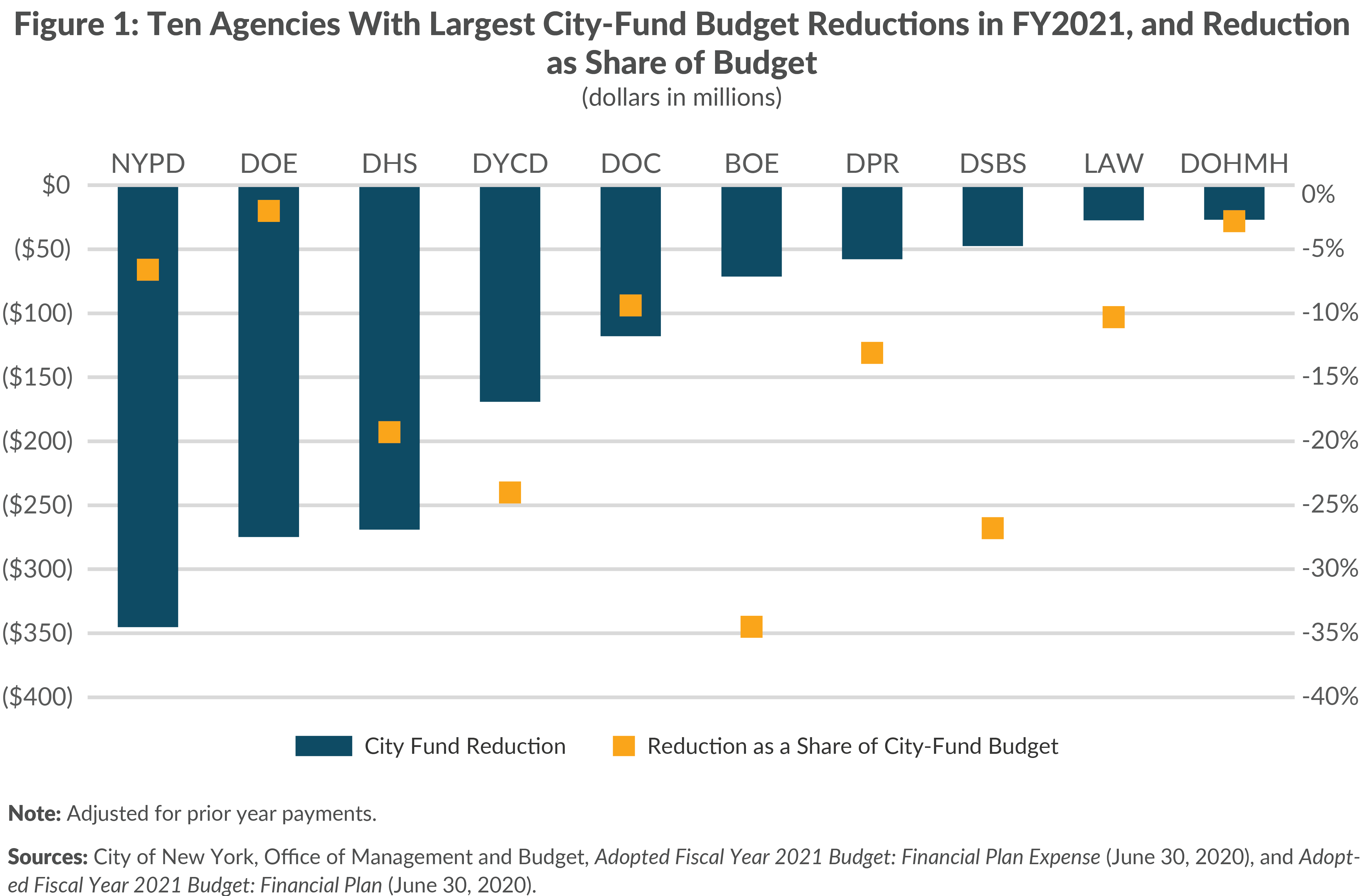FY2021 Agency Budget Realities
Increases vs. Decreases in City-Funded Spending
New York City’s Fiscal Year 2021 Budget is $92.8 billion when adjusted for the use of prior year resources and reserves. Of this $69.1 billion is backed by the City’s own revenues (such as taxes, fines, and fees), with the balance supported by federal and State aid.
City resources fund the majority of the Commissioner-managed operating budgets as well as central expenses, such as fringe benefits and debt service, that are managed and budgeted for on a citywide basis.1 In fiscal year 2021 fully 54 percent of City-funded spending, or $37.6 billion, is for agency operations, and is projected to decline by 2.2 percent or $838 million from fiscal year 2020; however, the City-funded workforce is expected to increase by 1,104 in fiscal year 2021.2
Year-over-year spending is projected to decline at 28 agencies for a total of $1.5 billion and increase at 48 agencies for a total of $652 million.3 Just 10 agencies comprise most ($1.4 billion) of the decline. (See Figure 1.) The greatest dollar cuts are for the New York Police Department (NYPD) ($345 million), the Department of Education ($275 million), and the Department of Homeless Services (DHS) ($269 million). The City-funded decline in DHS is offset by $127 million in federal aid. The planned reduction as a share of agency budgets varies significantly, but is smallest (2.0 percent) for the City’s largest agency, the Department of Education, which has an operating budget of $26.6 billion in fiscal year 2021 ($13.8 billion City-funded). Some of these declines are accompanied by headcount reductions, including 1,252 full-time and full-time equivalent positions at the NYPD and 1,975 at Department of Correction (DOC) due to closure of jail facilities.

Some small agencies had large proportional declines. They include the Department of Design and Construction ($24 million or 58 percent), Department of Emergency Management ($6 million or 18 percent), the NY County Public Administrator ($165,000 or 12 percent), all spending by Community Boards ($2 million or 11 percent), and the Law Department ($27 million or 10 percent). At eight agencies, including the public libraries, the year-to-year decline is projected to be less than 1 percent.
Most ($604 million) of the $652 million in City-funded spending growth is projected to occur in 10 agencies. (See Figure 2.) The City’s subsidy to New York City Health and Hospitals (H+H) is projected to increase $266 million due to collective bargaining agreements executed with the staff and increased funding for the NYC Care program. The $102 million City-funded increase at the Fire Department (FDNY) stems partly from one-time federal funding in fiscal year 2020 to cover eligible COVID-19 expenses. Similarly, the increase at the Department of Sanitation (DSNY) is partially due to lower than anticipated spending for snow removal in fiscal year 2020 due to the mild winter.4

More Spending Cuts Will Be Needed
The Mayor has not announced additional agency savings since the Adopted Budget. Given the budgetary risks facing the City, including further cuts in State aid and additional declines in tax revenue, the City will likely need to implement additional savings programs in fiscal year 2021, as well as to identify savings to close the $4.2 billion gap in fiscal year 2022. Additional hard choices will need to be made. The next round of cuts should aim to secure recurring savings, provide critical services to those most in need, and maintain the City’s competitiveness.

Technical Notes Worth Understanding
- Federal, state, and other categorical funds are excluded as these funds can vary substantially from year to year. For example, federal funds are budgeted at $12.5 billion in fiscal year 2020 and $7.4 billion in fiscal year 2021; the fiscal year 2020 increase reflected non-recurring funding for the COVID-19 pandemic. Additionally, the budget gap is based on City funds, not All funds.
- CBC budget figures are adjusted for prepayments, withdrawals from the Retiree Health Benefits Trust, and reserves to provide apples-to-apples spending comparisons between fiscal years.
- The City’s local Medicaid contribution is usually part of the DSS budget. However, it is reported separately here because the decline in city-funded expenditures is due primarily to higher federal aid. The local contribution to Medicaid is $948 million lower in fiscal year 2021 due to federal funding via the Federal Medical Assistance Percentage (FMAP) and timing, which shifted one payment across fiscal years.
Footnotes
- CBC staff divided the City funds budget into five categories: agency budgets, Medicaid, pensions, the miscellaneous budget, and debt service.
- Headcount data from City of New York, Office of Management and Budget, Fiscal Year 2021 Adopted Budget: Full-Time and Full-Time Equivalent Staffing Levels (July 1, 2020), https://www1.nyc.gov/site/omb/publications/finplan06-20.page, and email to Citizens Budget Commission staff (September 14, 2020).
- All community boards were collapsed and counted as one agency.
- Snow removal costs were $57 million in fiscal year 2020, but are budgeted at $101 million in fiscal year 2021.